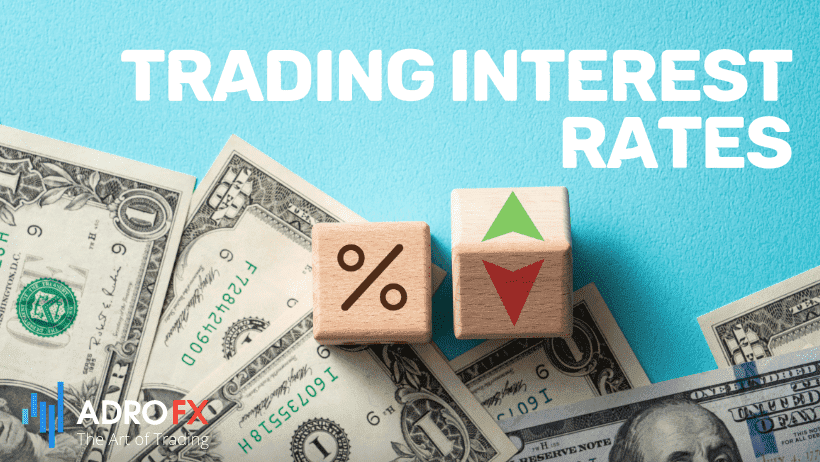Fundamentals of Interest Rates Trading

Interest rates hold the distinction of being the lynchpin of the financial market. Often, the trajectory of these rates plays a pivotal role in shaping the market's performance.
Take, for instance, the developments during the Covid-19 pandemic. As the Federal Reserve (Fed) initiated significant rate cuts and quantitative easing measures, the stock and cryptocurrency markets witnessed a remarkable surge. The combination of lowered interest rates and unconventional monetary policies spurred an unprecedented rally.
In stark contrast, the scenario in 2022 was quite different. The Fed, responding to an evolving economic landscape, enacted interest rate hikes exceeding 400 basis points. The outcome? Both stock and cryptocurrency markets took a downturn. This example underscores the substantial impact interest rates wield over these markets.
Yet, interest rates' influence is not confined solely to stocks and cryptocurrencies. They cast a wide net, touching many other facets of daily life. Take, for instance, the effect on the average person. When interest rates on mortgages and the cost of borrowing rise, it impacts individuals directly, influencing decisions regarding loans and homeownership.
In the ensuing exploration, we will delve deep into the world of interest rates and the central banks that play a vital role in shaping these rates. This comprehensive guide aims to equip you with a profound understanding of interest rates and their significance, empowering you to navigate the intricate terrain of the financial markets.

Understanding Interest Rates & Central Banks
Interest rates, represented as a percentage, are a critical aspect of the financial landscape. When you borrow funds from a bank or financial institution, the interest rate is the additional amount you must pay on top of the principal. Typically, this rate is expressed on an annual basis and is known as the Annual Percentage Rate (APR).
Central banks, entrusted with the task of managing a country's monetary policy, play a pivotal role in setting interest rates. Due to the sensitivity and importance of these decisions, many countries have insulated their central banks from political influences. Countries like Turkey, Argentina, and Zimbabwe have learned the hard way about the risks associated with mingling politics with such crucial decisions.
While all central banks are significant within their respective countries, there are a few whose actions resonate profoundly with investors and traders on the global stage:
- Federal Reserve: As the central bank of the United States, the Federal Reserve holds a position of paramount importance due to the size of the American economy. Moreover, the US dollar stands as the world's primary reserve currency.
- European Central Bank (ECB): With the European Union being the second-largest global economy and the euro as the second reserve currency, the ECB's policies hold substantial weight in financial markets.
- Bank of England (BoE): While the UK's economic prominence has diminished, the BoE still commands considerable attention worldwide. London's status as a financial hub contributes to this interest.
- People’s Bank of China (PBOC): China's stature as the second-largest global economy makes the PBOC's activities closely monitored by the international community.
- Bank of Japan: Japan's role in the global economy makes the Bank of Japan one of the world's most influential central banks.
In addition to these central banks, other notable institutions include the Swiss National Bank, the Reserve Bank of Australia (RBA), and the Turkish central bank.
Setting Interest Rates: The Central Bank Approach
Central banks, such as the Federal Reserve, the European Central Bank, and the Reserve Bank of Australia, operate with dedicated monetary policy committees that convene monthly to assess the state of the economy and decide on interest rates.
These meetings usually span two days and involve an in-depth analysis of the economy. Interest rates are adjusted based on the committee's evaluation. As a general rule, central banks reduce interest rates during economic challenges and raise them when the economy is performing well.
The Mechanism of Monetary Policy
The underlying principle of monetary policy is straightforward. In times of economic hardship, low interest rates stimulate spending by reducing the incentive to save. Additionally, they make mortgages and borrowing more affordable for individuals.
On the other hand, central banks raise interest rates to restore economic balance. The idea is that persistently low interest rates can lead to economic bubbles, which, if left unchecked, could burst with severe consequences. Therefore, central banks employ rate hikes to normalize the economy, ensuring its long-term stability.
Understanding the interplay between central banks and interest rates is vital for both seasoned investors and those new to the world of finance. It enables individuals to decipher the impact of monetary policy decisions on the economy and financial markets, ultimately aiding in making informed financial choices.

Trading Interest Rates
Trading interest rates encompasses a diverse array of strategies tailored to suit the financial market. Seasoned traders harness specialized tools that grant them direct access to the complex world of interest rates. An illustrative example of such a financial instrument is the rate swap, which thrives in the over-the-counter (OTC) realm. A rate swap serves as a contractual arrangement between two parties, facilitating the exchange of one stream of payments for another over an extended timeframe.
Conventional Assets: Capitalizing on interest rates can also be accomplished through the trading of conventional assets such as currencies and stocks. Typically, stocks exhibit a robust performance when interest rates are in a downward spiral. The rationale behind this phenomenon is that, in a low-interest-rate environment, investors tend to shift their capital from cash holdings, which offer lower yields, into alternative assets like stocks. A prime case in point is the stock market's remarkable rally amid the COVID-19 pandemic, triggered by the Federal Reserve's rate cuts.
In the currency realm, the carry trading strategy assumes significance. It involves borrowing a low-yielding currency and investing in high-yield counterparts, positioning traders to exploit interest rate differentials.
Metals and Currencies: Precious metals, including gold and silver, and currencies are also intricately intertwined with interest rates. Traditionally, precious metals experience an upswing when interest rates remain low, while the value of local currencies tends to depreciate in similar circumstances.
Futures Contracts: Trading interest rate decisions can be accomplished via futures contracts encompassing an array of asset classes. In a futures contract, participants enter into an agreement to either buy or sell an asset at a predetermined future date and price. Distinguished by the obligation to complete the transaction, futures contracts are distinct from options contracts.
Among the prominent futures contracts in the market are index futures, including the Dow Jones and the Nasdaq 100 index. Additionally, individual stock futures provide traders with opportunities to navigate a myriad of products.
Bond Market: Bonds, owing to their debt nature, exhibit heightened sensitivity to fluctuations in interest rates when compared to stocks. As interest rates ascend, governments and countries are compelled to revise their policies to align with the new rates. Consequently, higher interest rates translate to enhanced returns for bondholders. A pertinent example is the nearly zero American bond yields, coinciding with the Federal Reserve's decision to maintain interest rates within the 0% to 0.25% range.
The Influence of Interest Rates in Day Trading
Interest rates exert multifaceted effects on day trading, primarily underpinned by the level of interest rates. Elevated interest rates culminate in more stringent monetary conditions, subsequently impacting assets like stocks and cryptocurrencies. In certain scenarios, an environment characterized by elevated interest rates corresponds to decreased trading activities as stock market performance falters.
On the contrary, reduced interest rates, as vividly demonstrated during the COVID-19 pandemic, tend to stimulate greater participation among traders. In such circumstances, trend traders often thrive, capitalizing on the upward trajectory of various assets.
Furthermore, higher interest rates frequently exert an influence on corporate earnings. Many corporations witness a thinning of their earnings margins during these periods as heightened interest rates necessitate greater interest payments.
Conclusion
Interest rate trading is a multifaceted realm offering a myriad of strategies and considerations for traders and investors. From rate swaps to LIBOR, from conventional assets to futures contracts, this financial domain provides ample opportunities for those who seek to understand and harness the power of interest rates.
The influence of central banks, the dynamics of monetary policy, and the ever-shifting landscape of the bond market all play a pivotal role in the intricate dance of interest rate trading. As central banks convene to set interest rates, traders and investors keenly follow their decisions and adjust their strategies in response to changing economic conditions. Moreover, the bond market, characterized by its sensitivity to interest rate fluctuations, underscores the significance of interest rate trading as an essential component of financial markets.
Day trading, which thrives on the delicate balance of interest rates, illustrates how higher or lower interest rates can significantly impact the performance of various assets. The ebb and flow of market activity are intricately linked to the level of interest rates. High interest rates often lead to subdued trading, while low interest rates can trigger increased market participation and present opportunities for trend traders.
In a world where interest rates wield considerable influence on financial markets, the ability to navigate this terrain and employ diverse trading strategies is a valuable skill. Traders and investors who comprehend the intricacies of interest rates can make informed decisions and adapt to the evolving economic landscape.
This article has unraveled the intricacies of interest rate trading, delving into strategies, conventional assets, and their far-reaching impacts on the financial landscape. It is a testament to the ever-evolving dynamics of the financial world, and the central role played by interest rates in shaping the fate of markets.
About AdroFx
Established in 2018, AdroFx is known for its high technology and its ability to deliver high-quality brokerage services in more than 200 countries around the world. AdroFx makes every effort to keep its customers satisfied and to meet all the trading needs of any trader. With the five types of trading accounts, we have all it takes to fit any traders` needs and styles. The company provides access to 115+ trading instruments, including currencies, metals, stocks, and cryptocurrencies, which make it possible to make the most out of trading on the financial markets. Considering all the above, AdroFx is the perfect variant for anyone who doesn't settle for less than the best.










